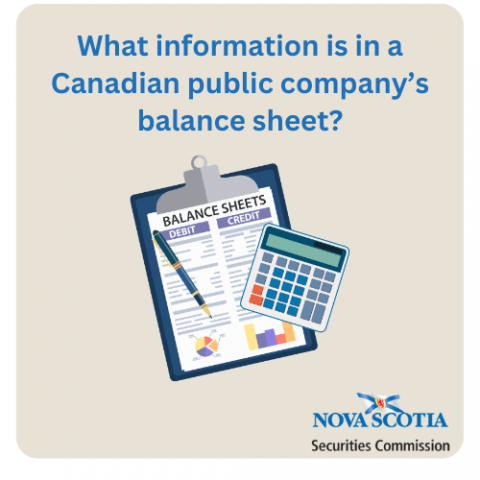Submitted by nsscadmin on

Staff at the Nova Scotia Securities Commission regularly deliver investor education presentations on basic investing to the public. Some questions we regularly get from beginner investors at these presentations are related to public company’s financial reporting, specifically their balance sheets. In Canada, publicly traded companies must release financial statements, including balance sheets every quarter, and annually.
Balance sheets may also be referred to as a statement of financial position. A balance sheet must list a company’s assets, liabilities, and shareholders equity. It is effectively what the company owns (Assets), and what it owes Liabilities) and the net difference known as equity. Here’s a closer breakdown of what each of those sections must include that may be of interest to you if you are thinking about investing, in a company or have an existing investment in a company.
Assets:
- Cash and Cash Equivalents: Money the company has on hand and any highly liquid investments it holds.
- Accounts Receivable: Money owed to the company by customers for goods or services it provided on credit.
- Inventory: Raw materials, work-in-progress, and finished goods for sale that the company holds.
- Investments: Any long-term investments held by the company.
- Property, Plant, and Equipment (PP&E): Land, buildings, machinery, and equipment owned by the company and used in its operations.
Liabilities:
- Accounts Payable: Money the company owes for goods or services it purchased on credit.
- Short-term Debt: Loans and other borrowings due within a year.
- Long-term Debt: Loans and other borrowings due in more than a year.
- Deferred Revenue: Payments received for goods or services not yet delivered.
Shareholders equity:
- Share Capital: The amount of money invested by shareholders when they purchased shares.
- Retained Earnings: Cumulative profits and losses that the Company has reported through its income statement. When a company pays a dividend, it reduces the retained earnings balance.
A balance sheet is a snapshot of a company’s finances at a specific time. It can give you insight into a company’s financial footing and is one tool available to you to help you decide if you want to invest. However, as with any investment be sure it fits your risk tolerance, and financial situation, and never invest more than you can afford to lose.
